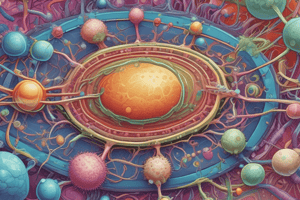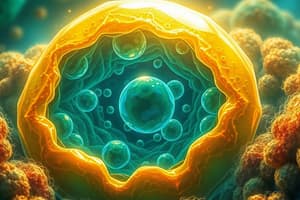Podcast
Questions and Answers
What are the differences in the internal structures of the cells?
What are the differences in the internal structures of the cells?
There are fewer structures in the cell on the top and the structures in the cells are similar.
Which cell structures are seen in all cell types?
Which cell structures are seen in all cell types?
DNA, cytoplasm, ribosomes, cell membrane.
What are organisms that contain more than one cell with membrane-bound organelles and a nucleus?
What are organisms that contain more than one cell with membrane-bound organelles and a nucleus?
Eukaryotes.
What are organisms that contain only one cell and do not contain a nucleus or membrane-bound organelles known as?
What are organisms that contain only one cell and do not contain a nucleus or membrane-bound organelles known as?
Which descriptions apply to prokaryotic cells?
Which descriptions apply to prokaryotic cells?
Which descriptions apply to eukaryotic cells?
Which descriptions apply to eukaryotic cells?
An interaction between two organisms in which one usually benefits is known as?
An interaction between two organisms in which one usually benefits is known as?
Which term describes the relationship in which one organism lives inside the other one?
Which term describes the relationship in which one organism lives inside the other one?
What statements are true of the relationship between termites and the protozoan that lives in their gut?
What statements are true of the relationship between termites and the protozoan that lives in their gut?
It is believed mitochondria evolved from?
It is believed mitochondria evolved from?
While chloroplasts evolved from?
While chloroplasts evolved from?
How is mitochondrial DNA used in science?
How is mitochondrial DNA used in science?
Is it possible today for a eukaryotic cell to live without mitochondria or chloroplasts?
Is it possible today for a eukaryotic cell to live without mitochondria or chloroplasts?
What provide evidence for the endosymbiotic theory?
What provide evidence for the endosymbiotic theory?
Which cell structures are seen in prokaryotic and eukaryotic cells?
Which cell structures are seen in prokaryotic and eukaryotic cells?
Identify the structures common to all cells: label a ___, label b ___, label c ___, label d ___.
Identify the structures common to all cells: label a ___, label b ___, label c ___, label d ___.
Which organisms are prokaryotes?
Which organisms are prokaryotes?
Which organisms are eukaryotes?
Which organisms are eukaryotes?
Flashcards are hidden until you start studying
Study Notes
Cell Structure Differences
- Prokaryotic cells contain fewer internal structures compared to eukaryotic cells.
- Internal structures between prokaryotic and eukaryotic cells are similar but organized differently.
Common Cell Structures
- All cell types share four key structures: DNA, cytoplasm, ribosomes, and a cell membrane.
Eukaryotes
- Eukaryotic organisms are multicellular and possess membrane-bound organelles and a true nucleus.
Prokaryotes
- Prokaryotic organisms are unicellular and lack a nucleus and membrane-bound organelles.
Prokaryotic Cell Characteristics
- Typically single-celled organisms.
- Lack membrane-bound organelles.
- DNA is located within the cytoplasm.
Eukaryotic Cell Characteristics
- Generally multicellular organisms.
- Feature a defined nucleus.
- Contain various membrane-bound organelles.
Symbiosis
- An interaction beneficial to one organism, known as symbiosis, can involve various living beings.
Endosymbiosis
- Describes a relationship where one organism lives within another, often providing mutual benefits.
Termite and Protozoan Relationship
- Termites derive nourishment from protozoans in their gut, while the protozoans receive shelter and food from the termites.
Evolution of Organelles
- Mitochondria are believed to have evolved from aerobic bacteria.
- Chloroplasts are thought to have originated from cyanobacteria.
Mitochondrial DNA Applications
- Mitochondrial DNA (mtDNA) is utilized in forensic science, particularly in cases involving missing persons to trace maternal lineage.
Survival of Eukaryotic Cells
- Eukaryotic cells cannot survive without mitochondria and chloroplasts, as they are essential for energy production.
Endosymbiotic Theory Evidence
- Mitochondria and chloroplasts can reproduce independently of the cell.
- They are similar in size to prokaryotic cells.
- Each contains its own ribosomes.
Shared Structures in Cells
- Both prokaryotic and eukaryotic cells have four essential structures: cell membrane, DNA, ribosomes, and cytoplasm.
Organisms in Prokaryotes
- Representative organisms include bacteria and various microorganisms.
Organisms in Eukaryotes
- Representative eukaryotic organisms include animals, plants, and fungi.
Common Cell Labels
- Key structures in all cells can be labeled as follows:
- A: Cell membrane
- B: Cytoplasm
- C: Ribosomes
- D: DNA
Studying That Suits You
Use AI to generate personalized quizzes and flashcards to suit your learning preferences.




